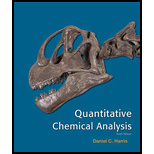
a)
Interpretation:
The most suitable elution (gradient or isocratic) for the mixture has to be identified.
Concept introduction:
Running a broad gradient helps us to decide whether to use gradient elution or isocratic elution. This can be decided by the gradient time and the retention time difference.
Gradient time is denoted by
Two conditions are possible by considering the gradient time and retention time difference. This can be given as shown below,
Simply to say if all the peaks are eluted over a very narrow solvent range means, the feasible one is isocratic elution. If a wide range of solvent is required means then the practical one that is possible is gradient elution.
b)
Interpretation:
The starting and ending percentage of Acetonitrile and gradient time has to be given.
Concept introduction:
Running a broad gradient helps us to decide whether to use gradient elution or isocratic elution. This can be decided by the gradient time and the retention time difference.
Gradient time is denoted by
Two conditions are possible by considering the gradient time and retention time difference. This can be given as shown below,
Simply to say if all the peaks are eluted over a very narrow solvent range means, the feasible one is isocratic elution. If a wide range of solvent is required means then the practical one that is possible is gradient elution.
Want to see the full answer?
Check out a sample textbook solution
Chapter 25 Solutions
Quantitative Chemical Analysis
 ChemistryChemistryISBN:9781305957404Author:Steven S. Zumdahl, Susan A. Zumdahl, Donald J. DeCostePublisher:Cengage Learning
ChemistryChemistryISBN:9781305957404Author:Steven S. Zumdahl, Susan A. Zumdahl, Donald J. DeCostePublisher:Cengage Learning ChemistryChemistryISBN:9781259911156Author:Raymond Chang Dr., Jason Overby ProfessorPublisher:McGraw-Hill Education
ChemistryChemistryISBN:9781259911156Author:Raymond Chang Dr., Jason Overby ProfessorPublisher:McGraw-Hill Education Principles of Instrumental AnalysisChemistryISBN:9781305577213Author:Douglas A. Skoog, F. James Holler, Stanley R. CrouchPublisher:Cengage Learning
Principles of Instrumental AnalysisChemistryISBN:9781305577213Author:Douglas A. Skoog, F. James Holler, Stanley R. CrouchPublisher:Cengage Learning Organic ChemistryChemistryISBN:9780078021558Author:Janice Gorzynski Smith Dr.Publisher:McGraw-Hill Education
Organic ChemistryChemistryISBN:9780078021558Author:Janice Gorzynski Smith Dr.Publisher:McGraw-Hill Education Chemistry: Principles and ReactionsChemistryISBN:9781305079373Author:William L. Masterton, Cecile N. HurleyPublisher:Cengage Learning
Chemistry: Principles and ReactionsChemistryISBN:9781305079373Author:William L. Masterton, Cecile N. HurleyPublisher:Cengage Learning Elementary Principles of Chemical Processes, Bind...ChemistryISBN:9781118431221Author:Richard M. Felder, Ronald W. Rousseau, Lisa G. BullardPublisher:WILEY
Elementary Principles of Chemical Processes, Bind...ChemistryISBN:9781118431221Author:Richard M. Felder, Ronald W. Rousseau, Lisa G. BullardPublisher:WILEY





